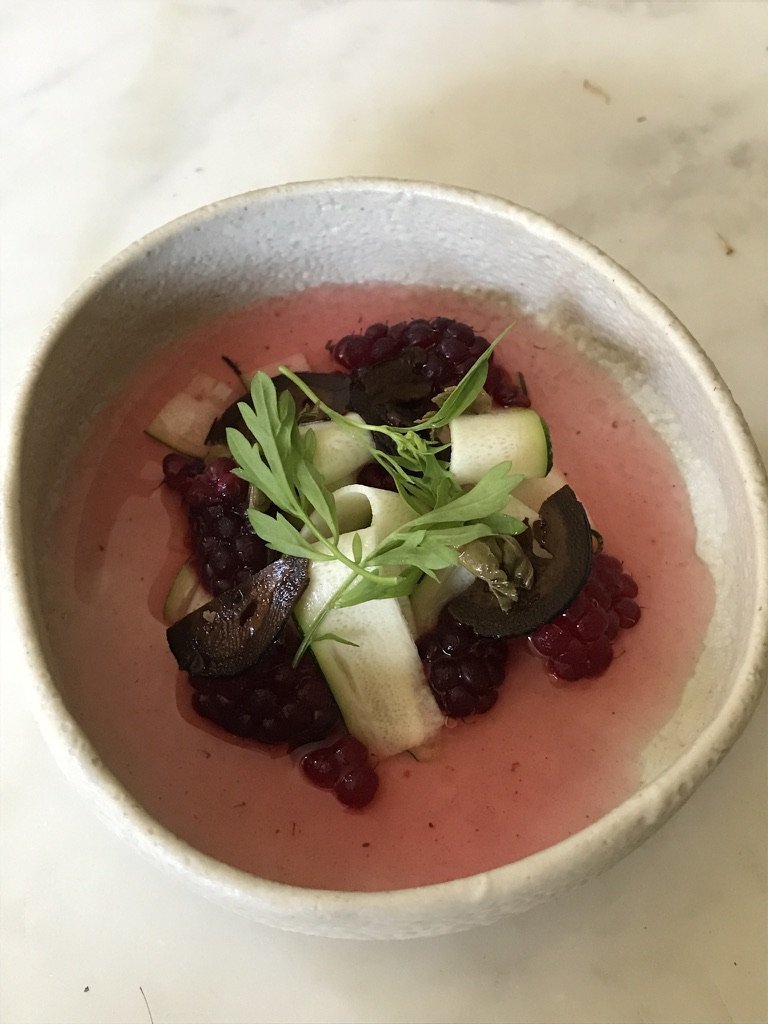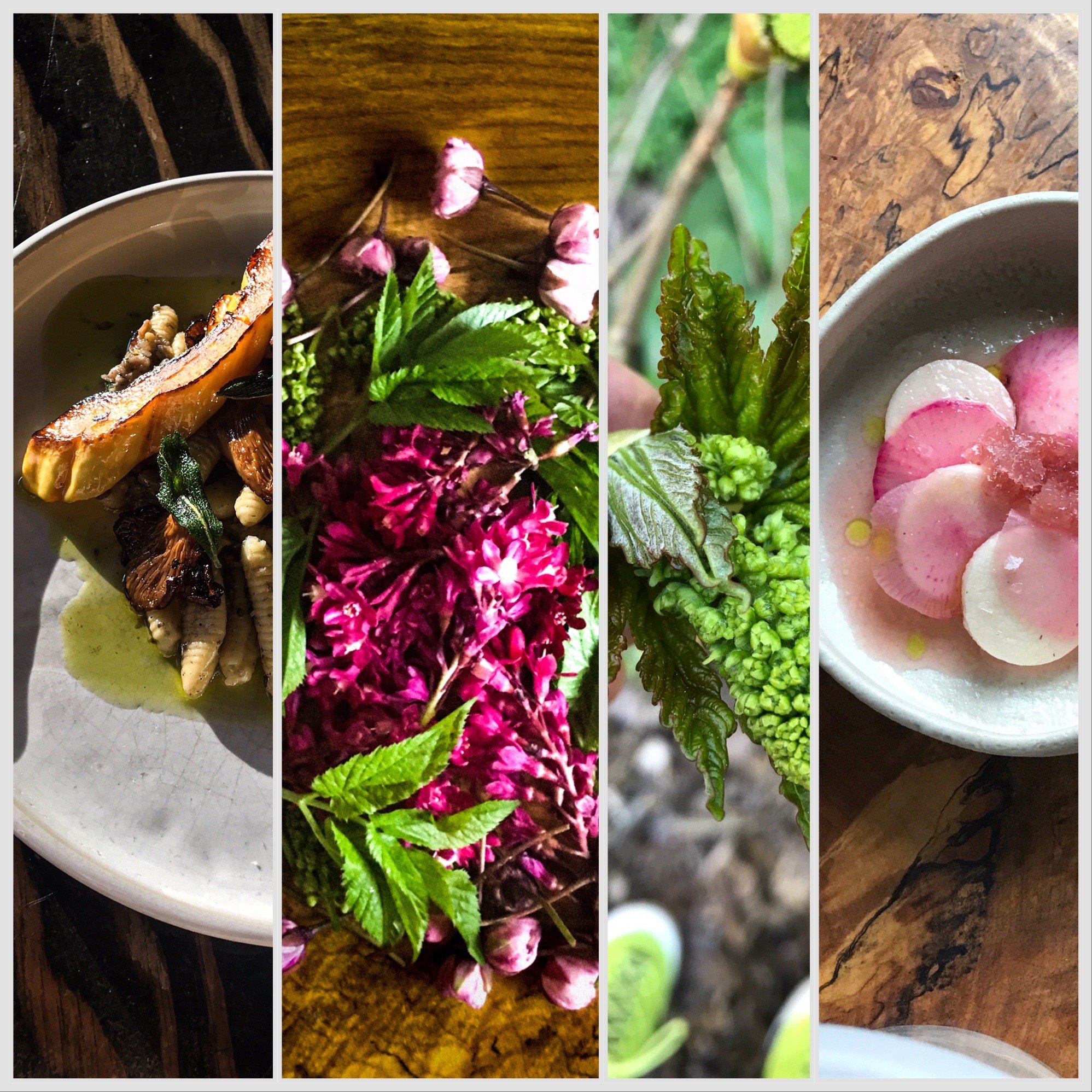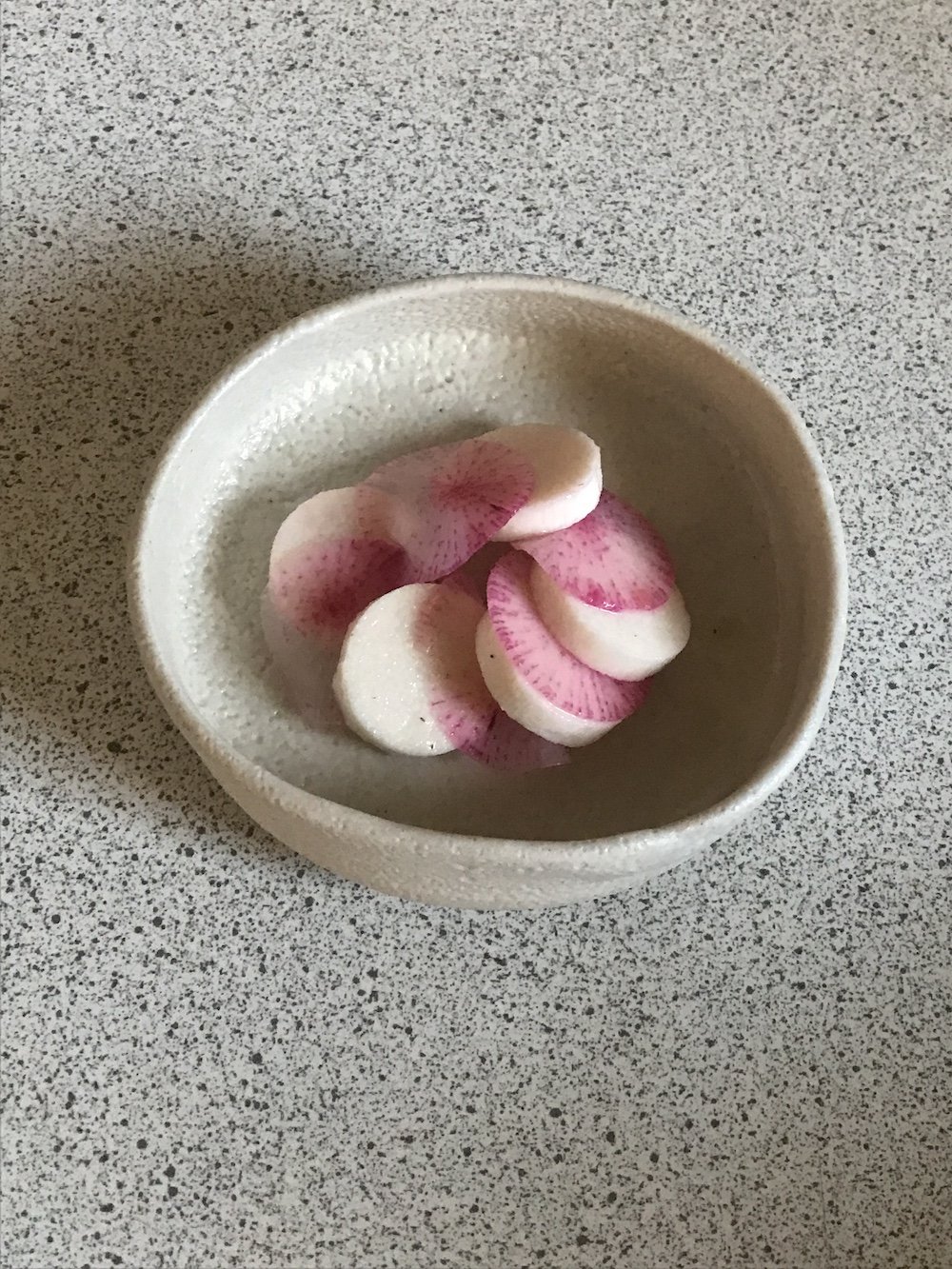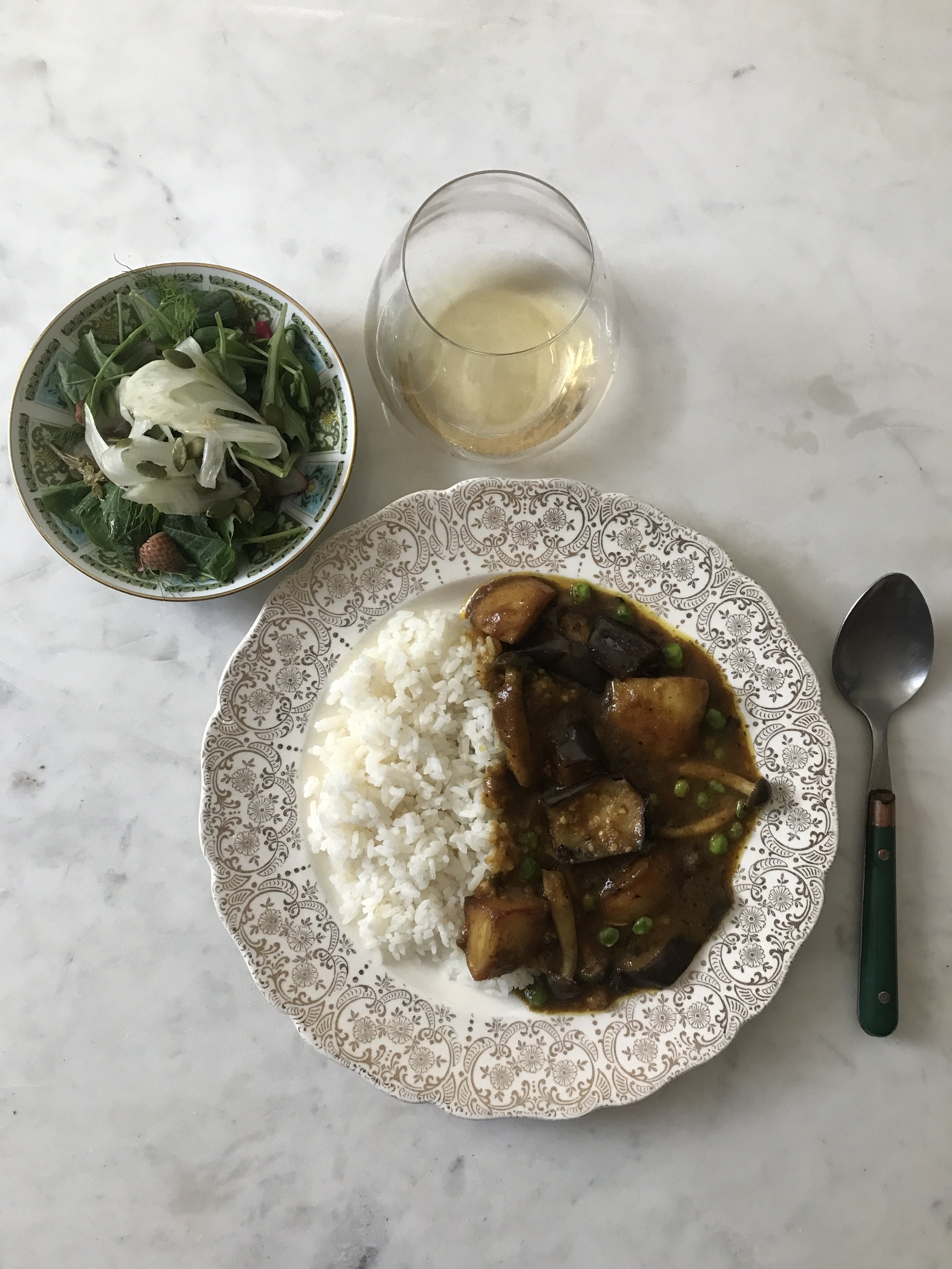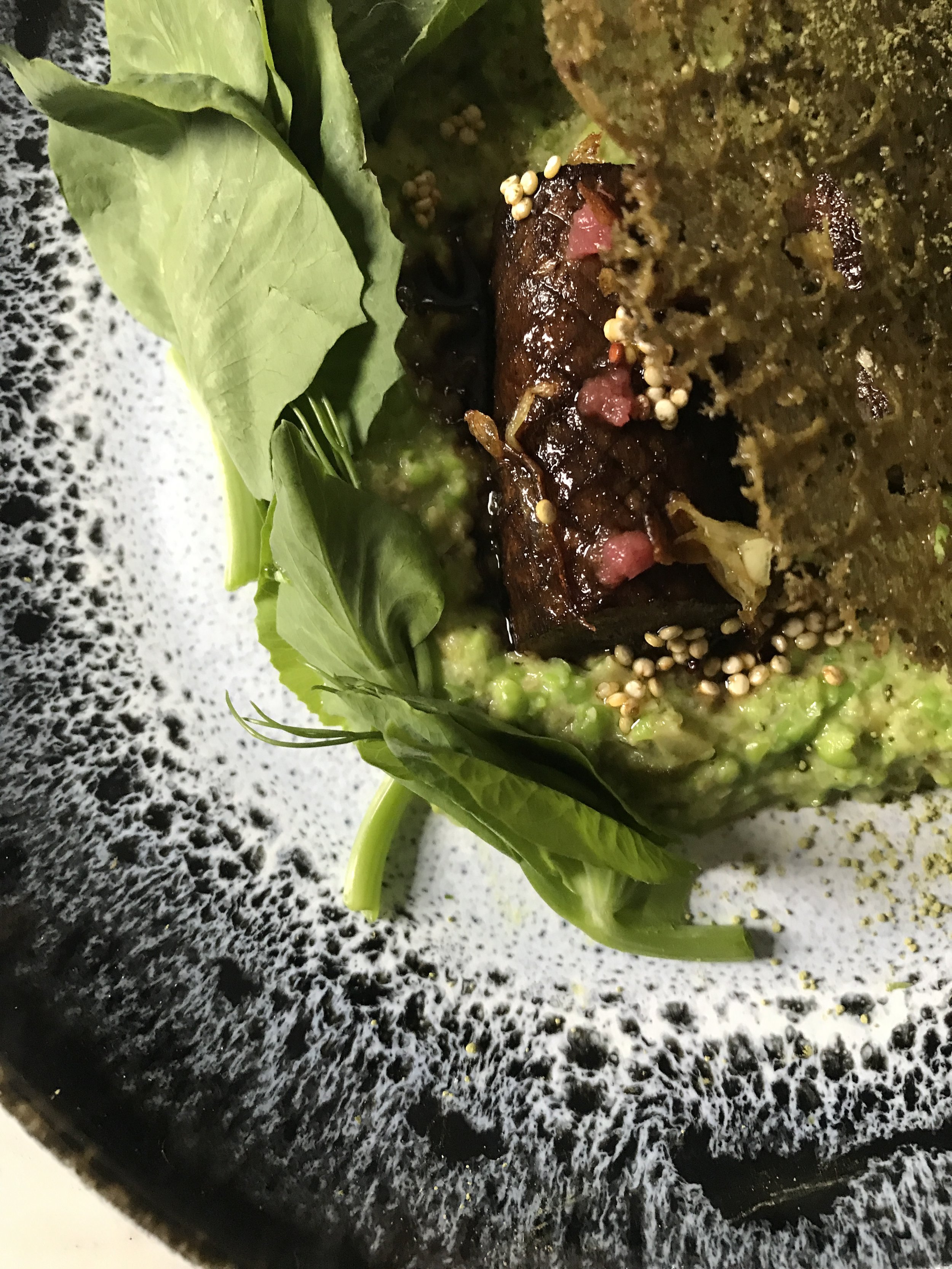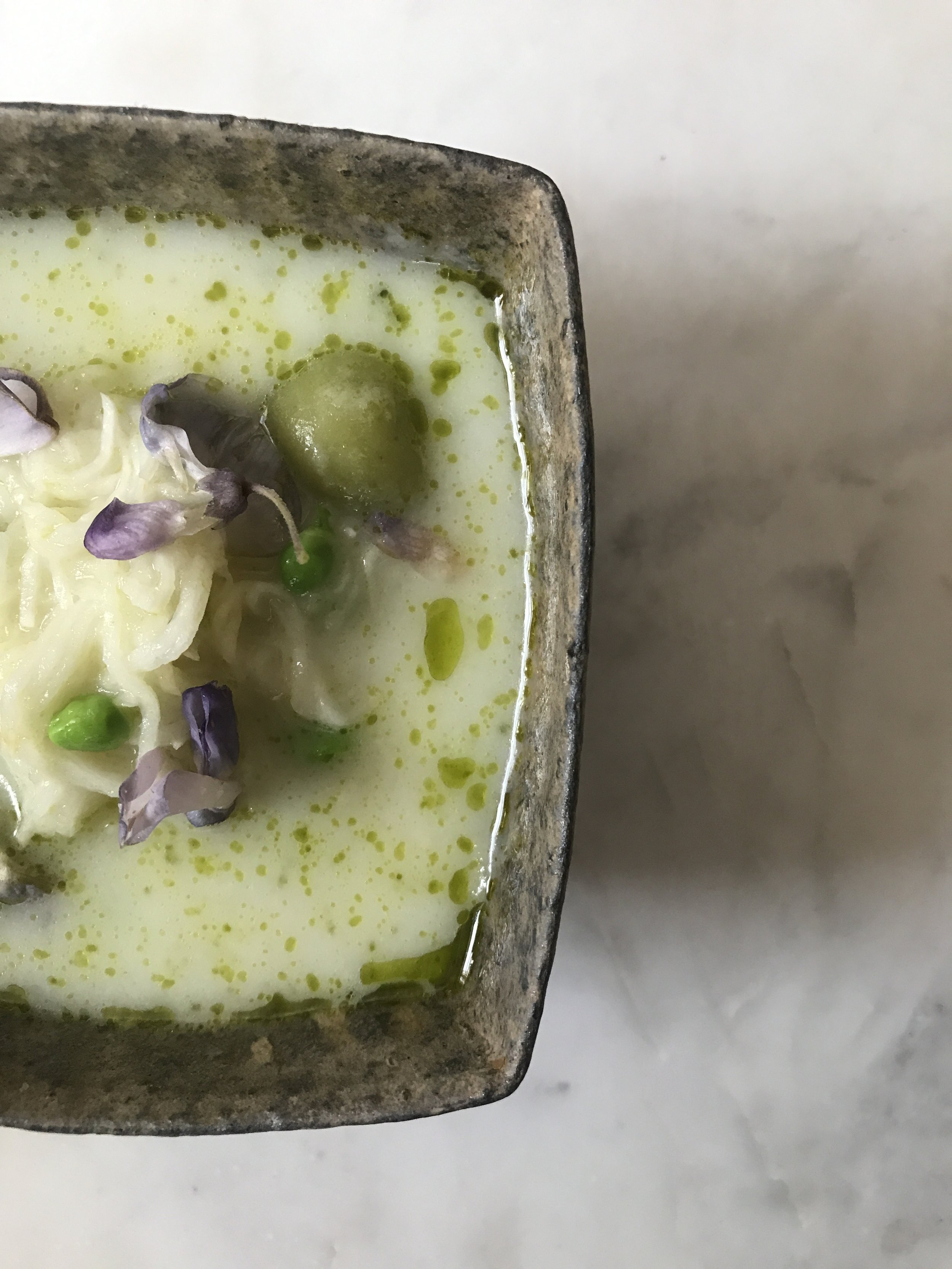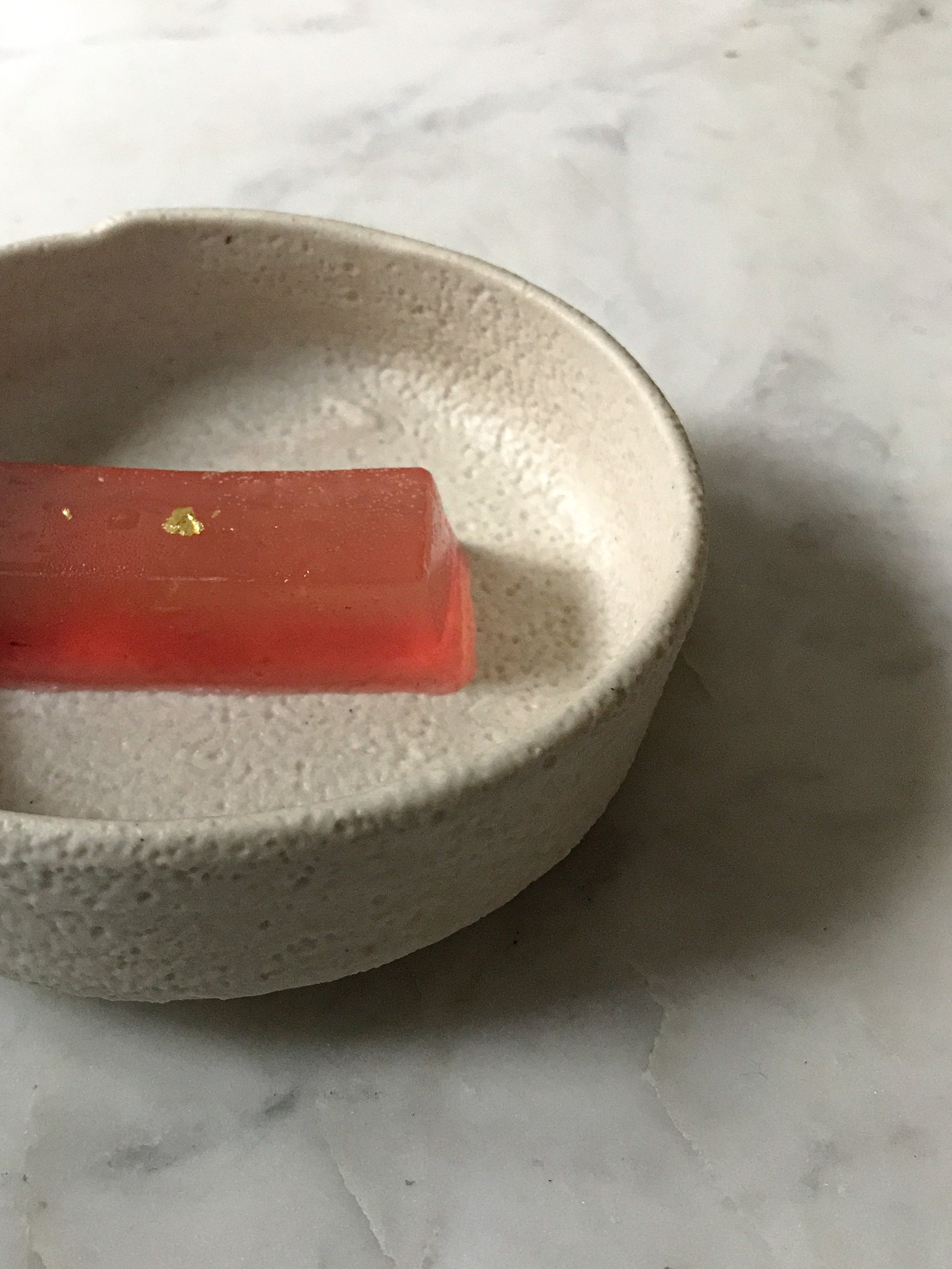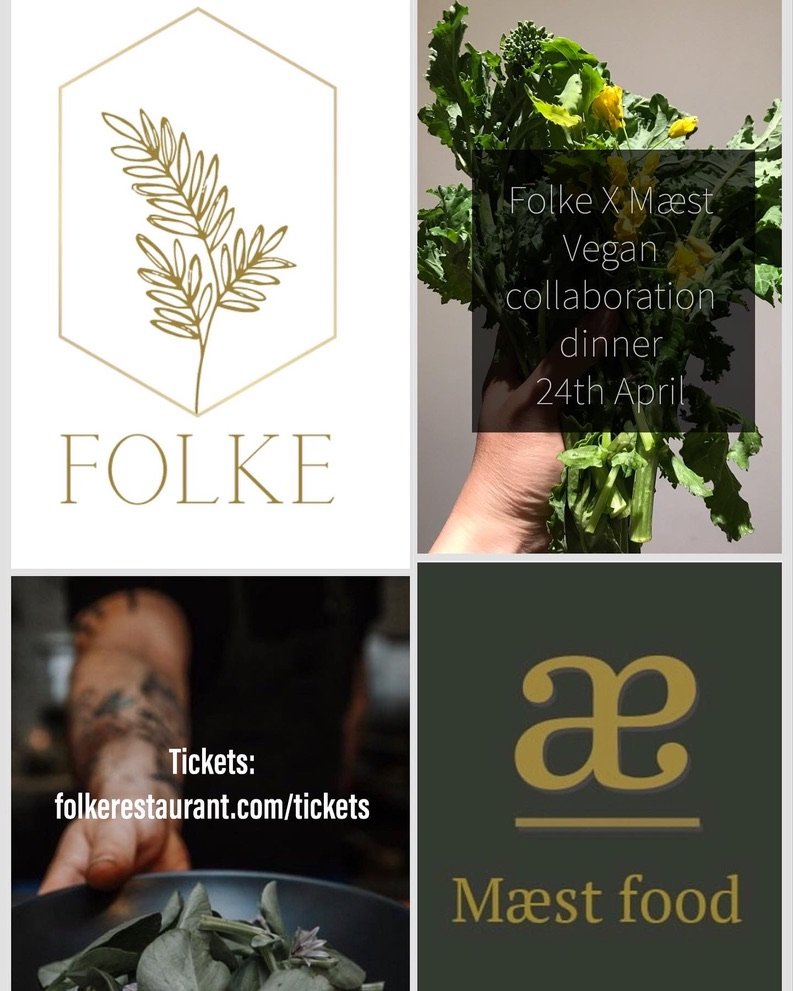Deep digging into a starch world.
In Japan, we have a deep tradition of artisans who dedicate their lives to mastering a single, specialized area, particularly in the food industry, or hand crafting.
One such example is the artisans who specialize in kudzu, a plant similar to arrowroot, used to make starch from its roots. Kudzu starch, or honkuzu, has a long history in Japan, possibly dating back to the 8th century.
Honkuzu (extra grade kudzu starch) is made by crushing the roots of kudzu plants that have grown for about 30 years. The fibers are repeatedly washed in water to extract only the starch, which is then dried.
This pure starch has been traditionally used in unique ways, such as in kuzu mochi(Chewy mochi like dessert), kuzukiri(chewly Jelly), and kuzuyu(Hot starchy drink). It's also widely employed as a thickening agent in Japanese cuisine, as well as in French and Italian dishes. Recently, honkuzu has gained attention as a health food, suitable for the elderly, baby food, and general health-conscious diets.
Beyond its culinary uses, kudzu has been a versatile plant in daily life for centuries. The fibers from the stems are woven into cloth, the leaves are used as livestock feed, young leaves are eaten or made into kuzuba tea, and there's even a belief that adding kudzu flowers to alcohol can prevent hangovers.
The process of making kiudzu starch is an intricate one, requiring both experience and a natural intuition. The craftsmen who venture deep into the mountains to find high-quality kudzu are known as horiko. These skilled artisans dig up kudzu roots, sometimes as thick as a person’s torso, using only shovels and hoes. It takes great patience to harvest the roots while keeping their shape intact.
Once the horiko deliver the roots, they are crushed to extract the starch. The starchy liquid, initially brown like soy sauce, is repeatedly washed in cold water until it turns pure white. The starch is then refined using pure cold water from the Akizuki mountains and a unique method known as "funaire" and "funaage." After refinement, the starch is naturally dried in a storehouse for six months to a year before it is ready for sale.
The entire process, from harvesting to refining, takes about a year and a half to two years. Remarkably, only about 7 kilograms of starch can be extracted from 100 kilograms of raw kudzu roots. This honkuzu, passed down through generations as a closely guarded family secret, is often referred to as “white gold.”
Well..I will write about the cooking method for kudzu next article.
BC's Stone Fruits Crisis: An Unexpected Challenge
British Columbia has been hit hard this year by an unexpected stone fruits crisis. While cherries have managed to survive the harsh conditions, peaches and plums have virtually disappeared from the farmers markets. This shortage stems from a devastating cold snap that struck the Okanagan orchards earlier this year, wiping out the peach and plum harvests. The repercussions of this event could affect the region's fruit harvests for years to come.
According to a recent news article, the damage caused by the cold snap was unprecedented. The loss is a stark reminder of the delicate balance our food system relies on and the increasing impact of climate change on agriculture.
In Japan, there’s a saying, "Peaches and chestnuts are three years, persimmons are eight years," which refers to the time it takes for these trees to bear fruit. Peach trees typically take three years to produce fruit. Unfortunately, the Okanagan orchards may need at least this long to recover, meaning the shortage of peaches and plums could extend beyond just this season.
At Mæst Food, the impact of this crisis hit close to home as I was planning to serve a dish featuring stone fruits for our latest dinner popup event(The first photo). Initially, I believed the lack of plums and peaches at the farmers markets was a temporary delay. However, as I waited and monitored updates from local farmers, it became clear that the situation was far more severe. One farmer's post confirmed the worst: they wouldn’t have any peaches or plums this year due to the loss of their fruit trees.
Climate change is not just a distant, abstract issue; it’s here, affecting our local farms and our food. The cold snap that caused the devastation in the Okanagan is a direct result of these changing weather patterns, underscoring the urgent need for sustainable practices and resilience in our agricultural systems.
Adapting to these changes is crucial. For our planned dish of heirloom tomatoes and fruits with herbs, I had intended to use the sweet, juicy flavor of peaches. With none available, I’ve decided to substitute blueberries instead. Cherries are almost end of season so this is a secure choice.(The last photo) is for a breakfast and lunch at Modus cafe popup.
While it’s a change from the original plan, it’s a delicious and locally available alternative that allows us to still celebrate the summer’s bounty.
This crisis serves as a poignant reminder of the importance of supporting local farmers and being flexible with our menus. By doing so, we can continue to create delicious, sustainable dishes that honor the hard work and dedication of our agricultural community, even in the face of adversity.
From Copenhagen to conscious cuisine
This spring, I found myself in the vibrant city of Copenhagen, attending the Mad Academy to deepen my understanding of environmental sustainability in the food industry. The academy, run by the visionary minds behind Noma, goes beyond being a world-renowned restaurant. It is like a part of a culinary movement led by René Redzepi, and my time there was nothing short of inspiring.
Learning from the experts and industry business owners at the Mad Academy, I gained invaluable insights into how climate change affects our food systems. This experience ignited a passion within me to spread René's message and advocate for sustainable practices in the culinary world. Food is central to our lives, and if climate change continues unabated, we face potential energy crises and, in extreme cases, food shortages.
In April right before I was going to Copenhagen, my best chef friend Sam(the dessert club)asked me to teach foraging, who had an interest in for a while.
Initially, I hesitated to teach anybody because I didn't feel responsible for ensuring people learned safe and sustainable foraging methods. But I realized the importance of sharing my knowledge that I built up 7 years.
We embarked on a journey through the forest, where I taught him how to forage sustainably.
While we were hiking, we chatted about if we can do an event together. That was a beginning of this event plan.
After I came back from the trip, I reached an event theme. Be kind to earth.
This upcoming event features a five-course tasting menu, with each dish focusing on sustainably sourced ingredients. While sustainability has always been a central theme of my regular events, this time, I am placing an even greater emphasis on it. By highlighting the importance of sustainable practices, I hope to inspire guests to consider the impact of their food choices on the environment.
Mæst Food X The Dessert Club
Plant-Based Collaboration Dinner at Folke Restaurant
Date: August 13th
Time: 5:00 PM / 8:00 PM
Venue: Folke Restaurant
Courses: 5-course tasting menu
Ticket Price: $85 (includes food, welcome drink and gratuity). Drinks are available for purchase at the table.
Tickets: [Link ]
Event ConEcept: “Be Kind to Earth”
Since April, we've dedicated ourselves to foraging and sourcing ingredients from local farmers' markets to capture the essence of short-season produce. Our menu is crafted with a focus on sustainability, using local and foraged ingredients whenever possible, and minimizing waste. This approach not only supports local farmers but also helps reduce our carbon footprint.
5-Course Tasting Menu:
Note: The following menu is a preliminary outline and may be subject to changes or additions.
Welcome drink : House made umeshu soda or seasonal soda
Amuse: Japanese Turnips, pumpkinseed puree, nasturtium blossoms (Tomoko)
Snack: Beets & wild cress, nut cheese (Sam)
Palette Changer: Green beans, Kuzu jelly, gooseberry leche de tigre (Tomoko)
Main: Fava beans,Chanterelle mushrooms
Dessert: Chocolate, BC hazelnuts, and wild blackberries (Sam)
We invite you to join us for an evening that celebrates the bounty of nature and the art of sustainable dining.
Photos in the link are examples from our past creations.
Remember the Dessert Club?
Back in 2020, he showcased his incredible pastry skills with rustic desserts at Red Wagon Bistro. In 2022, we collaborated for the popup "Will Travel for Food" at Grapes & Soda. After a hiatus from the culinary world, he’s back, focusing on pastry making.
Event Concept: “Be Kind to Earth”
Since April, we have been foraging and visiting farmers markets together to preserve short-season ingredients. Our event menu emphasizes sustainability by using local and foraged ingredients as much as possible and reducing waste to support local farmers, as well as reduce CO2.
Mæst Food by Tomoko Tahara:
Mæst Food is a unique venture centered on slow, research-based plant-based food content. We specialize in sustainable vegan dining events, menu development, cooking videos, and more. Our focus is on plant-based, foraged, and locally sourced ingredients, aiming to capture the best seasonal flavors while fostering a deep connection with the earth and our guests.
Who is “The dessert club”?
Exciting news! We are thrilled to announce a collaboration with The Dessert Club.
Wondering who’s behind it? Meet Sam! Many of you might remember his captivating creations from the stunning photos you’ve seen.
In 2020, Sam wowed everyone with his incredible pastry skills and rustic desserts at Red Wagon Bistro. His daily Instagram posts had people obsessed with his desserts. I was obsessed too. At the time, I didn’t know who was running the account. Then, one day, Sam asked me to collaborate through Instagram, and we worked together at his event, “Will Travel for Food,” which introduced his vegetarian Indian dishes and my vegan Japanese dishes in 2022. The event was special not only because of the food but also due to his unique collection of flight plates and cutlery. We served our dishes on his special plates to the guests.
Sam is multi-talented; he is a yoga teacher and was based in India before 2019. He has been traveling back and forth between India and Vancouver for 10 years after working for a good amount of time as a pastry chef in Vancouver.
This time, Sam is bringing his expertise to our event with innovative plant-based desserts, adapting his techniques to fit our sustainable and vegan ethos.
We will create a six-course tasting menu dinner, The dessert club by Sam Shem will create playful desserts and snacks. Mæst Food by Tomoko Tahara will create the main courses and other savory dishes.
Our Event Concept is “Be Kind to Earth”
Since April, we have been foraging and visiting farmers markets together to preserve short-season ingredients. Our event menu emphasizes sustainability by using local and foraged ingredients as much as possible and reducing waste to support local farmers, as well as reduce CO2.
Event Details:
Date: August 13th
Time: 5:00 PM / 8:00 PM
Venue: Folke Restaurant
Courses: 5 course tasting menu
Tickets link is here.
Plant-based fine dining secret dinner.
In the realm of culinary adventures, there's something captivating about a secret dinner.
It's not just about the clandestine nature of the event; it's the promise of an exciting gastronomic journey that sets it apart.
My initial foray into the secret dinners began with a humble concept: a popup focused on the art of slow cooking and research-based cuisine.
It was an exploration of flavors, textures, and techniques—a journey through the hidden gems of my pantry and the fruits of my R&D.
But as the wheels of creativity turned and my culinary vision evolved, I yearned to delve deeper, to create an experience that was more intimate, more refined, and distinct.
Thus, the idea for a curated, informal but elegant affair was born.
At the heart of this clandestine gathering lies a commitment to culinary excellence. Every dish is a testament to planning and unwavering dedication.
From the selection of unique ingredients to the delicate art of fermentation, each element is carefully orchestrated to deliver a variety of flavors unlike any other.
Drawing inspiration from traditional Japanese culinary techniques, I've infused the menu with a sense of reverence for the craft.
It's a celebration of simplicity and complexity, where every bite tells a story of centuries-old traditions and modern innovation.
But beyond the food itself lies the essence of the secret dinner experience—a sanctuary of relaxation and conviviality.
As guests gather around the table, the ambiance is serene, the atmosphere electric with anticipation.
Here, conversation flows as freely as the wine, as guests share their insights and discoveries with newfound friends.
It's a rare opportunity to engage in spirited discourse about food, flavors, and the art of dining—an experience that transcends the boundaries of time and space.
And as each carefully crafted dish is unveiled before a small group of discerning diners, it becomes clear that this is more than just a meal—it's a journey of the senses, a celebration of culinary ingenuity, and a testament to the power of shared experiences.
So, if you find yourself yearning for an adventure beyond the ordinary, consider venturing into the world of secret dinners. For within the confines of these clandestine gatherings lies a world of endless possibilities—a world where every bite is a revelation, and every moment a memory in the making.
Tickets and details, menu are here.
Wild flowering currant
Spring is finally here, bringing with it my busiest season! As soon as the weather starts to improve (which is quite the feat in rainy Vancouver winters), I make it a point to venture out into the forests. One of my favorite activities during this time is foraging for flowering currants. These beauties are native to BC and are almost emblematic of springtime here.
As I wander through the woods, I find myself in the company of hummingbirds, drawn to the vibrant blooms just as I am. Picking flowering currants feels like a timeless endeavor, as if I could do it forever and never tire of it. Did you know that there are different varieties of flowering currants?
One of the darker-hued varieties captured in my photos is Ribes sanguineum 'Pulborough Scarlet'. These specimens boast a delightfully acidic fragrance that fills the air around them. On the other hand, the paler blooms belong to the native variety, commonly known as wild flowering currant or Ribes sanguineum 'Atrorubens'. These carry a scent reminiscent of cucumber, with both sweet and acidic notes dancing through the air.
While I appreciate the unique qualities of each variety, I must admit a personal fondness for the native blooms. There's something about their aroma that resonates with me on a deeper level, though both share a similarly distinctive base scent that sets them apart from other spring flowers.
You can experience this wonderful aroma of either variety at an event hosted by my workplace, Acorn Restaurant: the Pamplemus-jus X Acorn Easter Brunch. “A unique brunch event to celebrate Spring and one of our favourite Okanagan wineries - Pamplemousse Jus!”
I am going to include the flowers on one of the menu item. Tickets are available now.
World traditional scrap cooking
In my recent YouTube video, I explored how traditional Japanese cooking adeptly incorporates scraps from cooking, not just leftovers from the previous day. I also delved into researching other countries' traditions for utilizing cooking scraps.
Broths and Stocks: Leftover vegetable peels, bones, and meat scraps are often utilized to create rich and flavorful broths and stocks. This practice not only reduces waste but also enhances the depth of flavor in dishes.
Animal Feed: Some kitchen scraps, like leftover grains, fruits, and vegetables, are repurposed as feed for animals such as pigs, chickens, and goats. This not only minimizes food waste but also provides additional nutrition to livestock.
Food Preservation: Various preservation methods, such as candying citrus peels, pickling vegetable tops, and drying herbs, extend the lifespan of scraps and add unique dimensions to dishes.
Regrowing Vegetables: Certain vegetable scraps, like lettuce bottoms, green onion roots, and carrot tops, can be regrown into new plants, offering a sustainable way to reduce waste and obtain fresh produce inexpensively.
Fertilizer: Kitchen scraps like coffee grounds and eggshells can serve as natural fertilizers for plants, enriching the soil and promoting healthier growth.
While these practices are effective in minimizing waste and maximizing resources, they may not necessarily result in standalone dishes like Kinpira cuisine. However, they align with the ethos of “Mottainai”, a Japanese term reflecting regret over waste, and demonstrate a commitment to sustainable cooking practices.
Kinpira exemplifies the Japanese approach of utilizing every part of vegetables to create delicious snack.
One notable example is when they cook fish, they use every part of the fish, including scraps and offcuts, to minimize waste and maximize flavor.
Exploring the history of “Mottainai” cooking in Japan adds a fascinating dimension to understanding how traditional Japanese cuisine has embraced sustainability and resourcefulness over centuries.
Here is my video, but you must read the description. There’s the recipe, also more about “mottainai”.
Vegan cassoulet- Recipe Vlog is back.
It's been a while since I began in 2022, but unfortunately, I couldn't sustain my recipe vlog. Perhaps now is the perfect time to reignite it, with hopes of maintaining consistency this time around.
Simple vegan cassoulet.
Cassoulet has been a popular menu item at my work, Acorn restaurant’s brunch.(I made their recipe with tomatoes.) If you like to try it for your inspiration, hurry. The menu is seasonal, soon to be changed. This recipe is simpler, easier version for home cooking.
++++++++
A rustic dish, cassoulet, but without meat. This dish is all about umami from vegetables and beans—creamy navy beans, or earthy chickpeas works, and perhaps even buttery lima beans does fit well. Carefully caramelize the vegetables is the key to get a good flavour. Interspersed amongst the legumes are simple but hearty flavourful vegetables—melt-in-your-mouth. There are meaty mushrooms adds good texture for fun bite. Finishing touch of roasted squash add a smoky complexity. Garnished with a generous scattering of fresh herbs would be great but it is an optional. It has been for a while. I started in 2022, but couldn’t continue my recipe vlog. Perhaps this is the good time to start again, and hopefully I can continue. Ingredients: Navy beans (dry)150g Onion 150g small dice Celery 200g small dice Carrot 150g small dice Mushrooms 4 pieces dice Garlic 1 clove sliced Squash 300g Veggie Stock 2L Bay leaf 2 pieces Thyme (optional) 1 sprig Parsley (optional) ciffonade Salt and pepper Miso 1TBSP(Optional) Apple cider vinegar 1 TBSP Smoky paprika pinch Oil around 150ml Preparations: Heat up oven 400F Sheet pan with silk pad or parchment paper Medium sized pot Draining basket Bowl Recipe @tomokotahara (@maest_food ) . Mæst food is providing unique vegan dining experiences. Event/menu development/food styling www.maestfood.com
Recipe @tomokotahara (@maest_food )
Another anecdote: I was searching for music for my vlog when I recalled that one of my coworkers creates relaxing tunes. I reached out to borrow some, and it turned out to be a perfect match for the video's vibes. Absolutely amazing! Grateful for this. If you enjoy his music, please consider following @whitecricketmusic
Marigolds thoughts
As I tried to use Marigold petals on an experiment, attempting to incorporate marigold petals into my XO sauce(the details are on my IG), I found myself delving into the fascinating history and diverse usages of this vibrant flower. Marigolds, known for their captivating colors and unique flavor, have a heritage deeply rooted in both the Americas and Eurasia.
The marigold, scientifically known as Tagetes spp, traces its origins back to the ancient civilizations of Mesoamerica. Indigenous peoples such as the Aztecs and the Maya were among the first to cultivate these dazzling flowers. Beyond their ornamental value, marigolds held a pivotal role in the culinary and medicinal practices of these ancient cultures.
Marigold petals, with their slight citrusy and peppery notes, were used to season and garnish an array of dishes. In Mesoamerica, marigolds were not just a feast for the eyes but a feast for the palate as well.
The exploration and voyages of Spanish and Portuguese adventurers in the 16th century brought marigolds from the Americas to European shores. Initially prized for their striking beauty, marigolds eventually found their way into European kitchens, where they took on a dual role as both ornamental and cooking.
As marigolds made their way to Southeast Asia and other parts of the continent, their culinary potential continued to unfold, enchanting chefs and home cooks alike.
In the vibrant tapestry of Indian and Southeast Asian cuisines, marigold flowers assumed a cherished role as a culinary herb. These radiant blossoms adorned a variety of dishes, with a special affinity for Indian sweets and desserts. Marigold petals, with their vivid hues and subtle flavors, brought visual and gastronomic delight to the dining table.
One notable application involved adding marigold petals to rice dishes like biryani, infusing the grains with both color and a gentle, aromatic essence.
The history of marigolds in the world of culinary arts is a captivating narrative that spans continents and centuries. From their indigenous roots in the Americas to their migration to Europe and eventual embrace in Asian cuisines, marigold petals have left an indelible mark on diverse culinary traditions.
As I continue to explore the possibilities of marigolds in my own cooking, I am reminded of the timeless appeal and versatility of this remarkable flower. Whether you're using them for their vibrant colors, unique flavors, or potential health benefits, marigolds continue to enchant and inspire culinary enthusiasts around the globe.
Chanterelle mushroom crisis
As autumn settles in, it's usually the season for chanterelle mushrooms in Vancouver. Their golden caps and earthy aroma grace the tables of farmers markets and restaurants across the city. However, this year, the hunt for these elusive fungi turned into quite an adventure, thanks to the uncharacteristically dry weather that has persisted through the late summer and early fall.
For weeks on end, Vancouverites enjoyed abundant sunshine, a rarity in this typically rain-soaked season. While the sunny weather brought its own share of joys, it also brought with it a challenge for mushroom foragers or enthusiasts like me who eagerly await the chanterelle season.
The absence of rain was a cause for concern among foragers and mushroom enthusiasts alike. Chanterelles thrive in damp, woodland environments, and the dry conditions were far from ideal for their growth. I scoured the farmers markets, checked with local suppliers, and even consulted fellow mushroom aficionados, but to no avail. There was a noticeable absence of these coveted fungi on the market.
I began to contemplate the possibility of sourcing chanterelles from other regions. Thoughts of ordering them from Saskatchewan crossed my mind, but the idea didn't sit well with me. I wanted that authentic, local chanterelle experience that captures the essence of Vancouver's culinary identity.
Then, as if in response to my mushroom-seeking prayers, today's farmers market visit brought an unexpected surprise. There, nestled among the stalls, I spotted them – beautiful BC chanterelle mushrooms. My face broke into a broad smile, and I couldn't contain my excitement as I approached the vendor.
I struck up a conversation with the vendor, expressing just how much I had been anticipating this moment. It turns out; I wasn't the only one in pursuit of these elusive treasures. Many others had been eagerly awaiting the arrival of these mushrooms as well.
With a bag of freshly foraged BC chanterelles in hand, I couldn't wait to get home. These mushrooms were destined to be the star of my event. The unique peachy fragrance of chanterelles was exactly what I needed to complement my miso eggplant and aboriginal rice main dish. You will try this year's first chanterelle. The event date is 27th September.Tickets are here.
As I headed home with my prized find, I couldn't help but reflect on the unexpected turns and twists of this year's chanterelle season. The dry weather had posed a challenge, but it had also made the eventual discovery all the more satisfying.
In the end, my persistence and patience paid off, and I'm now looking forward to serving the exquisite flavors of BC chanterelle mushrooms, a reminder of the wonders that nature and our local farmers markets have to offer, even in the face of unexpected challenges.
Vegan Farm to table dinner vol.13
Vegan farm to table dinner vol.13 -
This time we will have four course menu as a prixfixe.
The event details are below of the main article.
A part of the food ingredient researches, I was looking at a history of Canadian wild rice since I am planning to serve Saskatchewan wild rice for the side of the main course.
The rice has hard texture, require some cooking techniques.
When it was cooked well, it was very tasty. Nutty earthy sweet flavour, starcher than I expected.
I think western people are using it for stuffer(like for turkey) as a grains, for indiginous people, wild rice had cultural and spiritual significance for their communities. It was often used in ceremonies, feasts, and as a symbol of sustenance and abundance, and it is used for many ways.
Image: Savor magazine
The wild rice is typically found in shallow, freshwater lakes, rivers, and marshes. Traditionally, Indigenous people harvested the rice by hand-paddling canoes through the stands of wild rice and using wooden sticks or knockers to gently dislodge the grains into the canoe.
Can you imagine paddling a canoe wild rice bushes on the lake and harvesting them? It looks fascinating.After harvesting, the rice was sun-dried and then parched to remove the outer husk. This process involved roasting the rice over a fire, which caused the outer hull to crack and allowed the inner grain to be easily removed. The resulting wild rice was then stored for later use or traded with neighboring tribes.
Enjoy our short course menu with effortless price.
September 27th(Wednesday)
At Modus coffee
Take out option is also available
Join us for Autumn Prix Fixe dinner.
A seasonal, thoughtful four-course dinner, plus a special gift, all for $46.5, tips included.
While our Farm-to-Table dinner series typically features 6-7 courses, this time we're offering a unique fixed-price menu with shorter courses. This presents a fantastic opportunity to try our culinary creations with effortless price.
Cash bar(we take CC) is at the event, we will serve natural/bio dynamic win
Tickets link is here
Japanese curry thoughts part 3
This blogpost is introducing @maestfood(@tomokotahara) presents Curry & Wine Night @moduscoffee. Tickets link is here.
Curry is an immensely popular comfort food in Japan. But what elevates this ordinary comfort food to a special culinary experience?See our instagram posts how it is special.
By the way, here is the series of Curry thoughts.
Part 3.
This is the reason why I came up with the idea to drizzle a finishing sauce over the curry.(we will serve a topping sauce with the curry rice)
In the tapestry of Japanese culture, culinary traditions weave a vibrant thread that reflects the nation's history and influences.
As we delve deeper into the world of curry, an integral part of Japanese cuisine, we encounter not only recipes and flavors but also personal anecdotes that shed light on the significance of this dish.
In this third installment of our series, we peek into the life of my father, a man whose culinary habits mirror a time when flavors were robust and ingenuity was celebrated.
My father, a quintessential representative of the early Showa-era and the post-war period, possesses a culinary disposition that resonates with the essence of his generation. An individual who staunchly refrains from donning the apron, he prefers savoring the delights prepared by others.
However, his adoration for a sumptuous meal knows no bounds. This peculiarity came to light one day when I, brimming with culinary enthusiasm, created a delightful salad replete with a crafted dressing.
Yet, much to my surprise, my father opted for an unconventional twist – substituting my dressing with a drizzle of soy sauce. The sheer audacity of this act left me momentarily bewildered. In retrospect, it was not merely an instance of culinary experimentation but a glimpse into the traditionalist mindset that holds steadfast in his heart.
Time has a fascinating way of transforming perspectives, and my father's journey with sauces stands as a testament to this phenomenon. Gradually, he began to appreciate the nuances of my crafted dressings, finding their synergy with the salad's flavors.
A nod to the changing times, he adapted his palate to this new reality, embracing the harmony between ingredients and dressings. The shift from soy sauce to the bespoke dressing symbolized an evolution, both in his culinary preferences and the shifting culinary landscape of Japan.
Yet, his affection for sauces remained unwavering. A jar of Bulldog brand Worcestershire sauce found a permanent place on our dining table, a testament to his fondness for its distinctive tang. His culinary compositions often featured this prized condiment, a signature touch that added a familiar and cherished flavor to the simplest of dishes. The marriage of soy sauce or Worcestershire sauce with his daily meals was akin to a special flavors.
A musing that often reminded my mind was the potential risk of an overdose of saltiness in his culinary concoctions. How could one not ponder whether this enthusiasm for sauces, born from a particular era's culinary constraints, might tip the scales of taste? However, it dawned on me that my father's penchant for flavors was more than just a pursuit of taste. It was a tribute to his generation's culinary identity, a nostalgy to the era when soy sauce was commonplace, and Worcestershire sauce symbolized innovation.
Perhaps the allure lay not solely in the taste but in the resonance of heritage and history. My father's culinary choices embodied a cultural ethos, reminding us that flavors transcend the realms of the palate to tell stories of times gone by. The journey of my father's palate traverses not just the dinner table, but through the annals of Japanese history, reflecting a time when ingredients were scarce, and creativity was paramount.
As we savor the flavors of curry and delve into the narratives intertwined with it, we are reminded that every dish holds within it a myriad of stories. In the world of culinary artistry, each taste, each drizzle of sauce, is a brushstroke on the canvas of culture, reflecting the rich tapestry of human experiences. So, the next time I see my father pouring sauces with unbridled enthusiasm, I am reminded not just of a culinary quirk but of a generational legacy that continues to shape our palates and perspectives.
Japanese curry thoughts 2
This post is basically introducing our curry and wine event - the tickets and details are here but I would like to write about how deeply attached Japanese people are to Japanese curry.
Part 2 :
Japanese curry fits into the distinctive Japanese culture by being adaptable, convenient, comforting, and customizable, while also showcasing Japan's willingness to embrace and modify foreign influences to create something uniquely its own.
Japanese culture has a history of being skilled at adapting and modifying existing concepts rather than creating entirely new ones from scratch.
This trait is evident in the case of Japanese curry as well. While the origins of curry are not native to Japan, the Japanese people have effectively taken the idea of curry and modified it to suit their tastes, preferences, and lifestyle.
Japanese curry was introduced to Japan during the Meiji era (late 19th century) through interactions with British navy officers and the introduction of curry roux cubes. However, the Japanese adapted the recipe to suit their own tastes. The milder and sweeter flavor of Japanese curry compared to traditional Indian or Thai curries aligns with the Japanese preference for subtle flavors.
The curry became especially popular during the 20th century due to its ease of preparation and its compatibility with the fast-paced modern lifestyle. Curry roux blocks, which are pre-made mixes of spices and thickening agents, made it convenient for people to prepare a quick meal at home.
It is often associated with home-cooked meals and comfort food. It's frequently served in households, schools, and cafeterias, even at camping trip. This connection to domestic life and nurturing fits well with the family-oriented and communal aspects of Japanese culture.
Over time, Japanese curry has come to be seen as a national dish, and its popularity is evident in the ubiquity of curry restaurants and its presence in convenience stores and even fast-food chains - also it has even found its way into community events and festivals. Curry festivals are held in various parts of Japan.
Japanese curry is a part of life and culture in Japan.
Japanese curry Thoughts
This post is basically introducing our curry and wine event - the tickets and details are here but I would like to write about how deeply attached Japanese people are to Japanese curry.
Part one:
When one hears the word "curry," thoughts of India's aromatic spices or Thailand's rich and flavorful dishes might spring to mind, especially in the Western world. However, in the unique culinary landscape of Japan, "curry" takes on an entirely different meaning—it refers to none other than Japanese curry, a dish that has solidified its place as one of an important food culture. Japanese curry is far more than just a dish; it's a cultural emblem of comfort, nostalgia, and unity.
In a country renowned for its iconic dishes like Sushi and Ramen, Japanese curry holds a distinct position due to its widespread popularity transcending generations. From the youngest members of the family to the elders, this dish has managed to capture the hearts and taste buds of people from all walks of life.
One of the remarkable aspects of Japanese curry is its accessibility. While Sushi requires a level of craftsmanship and Ramen demands meticulous preparation, Japanese curry takes a more approachable route. Thanks to the availability of pre-packaged curry roux from various companies in Japan, each household can infuse their unique touch into this beloved dish, creating a personal curry recipe that resonates with their taste preferences.
Interestingly, despite the convenience of boxed curry, it's not uncommon for families to have their own special curry recipes passed down through generations. This culinary tradition adds a heartwarming touch to the dish, making each serving a connection to cherished memories and a symbol of home-cooked comfort.
For many, the mere mention of Japanese curry triggers fond recollections of mother's ideas in their home kitchen. The nostalgic aroma wafting through the house, the anticipation of gathering around the dinner table, and the heartwarming flavors that never failed to bring solace—these elements combine to form a memory of home cooking.
The significance of Japanese curry extends beyond personal kitchens and into various aspects of Japanese society. Even within school cafeterias or school meal at the classes, this dish maintains its revered status. It's not uncommon to find Japanese curry as a monthly staple on school menus, further solidifying its role as a culinary touchstone that unites people of all ages.
So and so, our curry is not like a home edition, that is unable to make it usual home since it requires complex processes.
Overall, we hope you will enjoy tasty Japanese curry and wine at our event, the details are here.
Japanese burdock vegetable
These burdock on the photo is a specific type of burdock vegetable commonly found in Japan. We are lucky to have a glower here in Vancouver.
Burdock itself is a root vegetable that is often overlooked or underrated. It has a distinct earthy taste, which is being compared to the taste of the soil or earth.
When it comes to local Japanese burdock, it is important to note that it is typically more expensive in the market compared to imported burdock varieties. This indicates that it is considered a high-quality and sought-after vegetable.
What sets this burdock apart is its unique flavor profile. It is known for being flavorful with an earthy and muddy aroma. Additionally, it has a touch of sweetness, which adds to its overall taste experience.
it has a certain dryness, so it requires some processing or preparation before being cooked in a dish.Also unique bite texture. It is fibrely, if you cook properly, the texture gets tender.
Japanese variety of burdock vegetable that has rich flavor, earthy aroma, and subtle sweetness.
We will serve the burdock for a part of our main course - Karaage.
After careful deliberation, a change has been made to our menu. In lieu of the originally planned slow-cooked burdock, we are thrilled to present our patrons with an exciting dish - burdock and artichoke karaage. Though karaage may sound ordinary at first, we assure you that this rendition is anything but average.
Considerable effort has been invested in crafting a dish that showcases intricate layers of flavors and textures. Our attention to detail begins with the special burdock itself, which has undergone special preparation techniques. By tenderizing the burdock , we have created a culinary delight that promises an exciting flavor and texture experience.
To elevate the meal's character, we have chosen to serve it with a side of mushy peas, a beloved British classic. However, we have infused our own twist into this familiar side dish by incorporating pumpkin seeds and yuzu citrus, which impart a refreshing and vibrant element to the plate.
For those seeking an extraordinary seasoning experience, we present a traditional Japanese addition - @tsuentea Matcha salt. This unique seasoning boasts refreshing notes that beautifully complement the dish's richness, resulting in a harmonious balance of flavors.
Initially, we contemplated serving the main course with a pine cone reduction sauce. However, after careful consideration, we have decided to omit it from the dish. Nonetheless, for the curious and adventurous, we may offer it on the side bbq-ed onigiri rice balls. Our commitment to maintaining a well-balanced flavor profile led us to this decision. Actually, it is perfect for the rice balls. Slight pine flavour and tamari..
This dish promises to captivate discerning palate. We invite you to join us on a culinary journey that celebrates innovation and showcases the true artistry of our kitchen.Event tickets are here.
Vegan burrata - Maest food vegan farm to table dinner series vol.12 menu teaser
Vegan burrata cheese.
Vegan burrata with strawberries.
This dish is for Maest food (Tomoko Tahara) solo event - vegan farm to table dinner series vol.12.
June 20th at Folke restaurant.(Kitsilano) ticket link is here.
Creating a vegan burrata with a delightfully gooey texture was like a challenge, but I figured it out the quest -but the trick is a confidential.
Actually it has fermented sour taste since the mixture is fermented!
It is not made with tofu nether.
Experience delights with combination of creamy lukewarm vegan cheese with refreshing cold savoury miso strawberry sauce, fresh local strawberries. To add a satisfying crunch, alongside salty translucent seed crackers.
Double layered jelly.
Double layered jelly. This is our pallet changer. A small refreshment before a dessert.
Green apricots and flowering currant jelly.
Green apricots have a distinct taste compared to fully ripe apricots. The taste of green apricots is often described as slightly sour or tangy, with a hint of sweetness. They have a unique fruity flavor that is not as intense as fully ripe apricots but still enjoyable, also have a subtle almond-like flavor. This flavor is often associated with apricot pits or kernels, which have a slightly nutty taste. It adds a pleasant depth to the overall flavor profile of green apricots.
The combination of green apricots and flowering currant jelly are a delightful pairing. The sourness of the green apricots can complement the sweetness of the flowering currant jelly, creating a balanced and flavorful combination. The almond-like flavor of the green apricots can also add an interesting twist to the overall taste experience.
By creating a double-layered jelly, you can enjoy the distinct flavors of both ingredients in a visually appealing manner. The contrasting of amber colour and gentle red colour reminds me a sunset.
Maest food (Tomoko Tahara) solo Vegan Farm to Table Dinner Series Vol.12.
20th June 2023 At Folke restaurant 2585 W broadway(Kitsilano)
This time, the menu is all gluten free.
Ticket link is here.
Menu:
1.Kelp chips,tonburi, morells, wild pickles
2.Vegan Burrata.Elder flower.Strawberry & miso. Seed crackers.
3.Turnip noodles. Mugwort mochi. Peas. Herbs
4.Burdock.rubarb. Pine cone honey.Artichoke.Seasonal beans.
5.Flowering currants and green apricot jelly
6.Monaka wafers. Cherry blossom ice cream.Seasonal fruits.
*We will have feature drinks :
cocktails, wine and non alchols.
Feature bottle cocktails by Kaname (Grapes and soda )
Vegan biodynamic wines selections from BC wine provider Ian and wine.
For sobers, our forest inspired sodas. Available at the cash bar on the day.(accepting cash/credit card/debit) .
Also a bonus! Our playlist of the night is created by Vancouver DJ, Nina Mendoza .
Unveil our sauces.
I am finishing up the menu for Maest food solo vegan farm to table dinner event.
Maest food (Tomoko Tahara) vegan farm to table dinner event vol.12 event details are here.
I am introducing here about our sauces and key ingredients for the main course.
Pine cone reduction sauce:
Pine cone honey, a labor of love. Crafted over several weeks, this "honey" is a vegan creation, a thick pine cone syrup that imparts a unique and complex flavor. This delectable sauce is for the roasted burdock that prepared through layers of cooking process. By reducing the pine cone honey with soy sauce and adding a touch of umami-rich seasonings, created a wonderful tare sauce, combining the well-balance of saltiness and sweetness to the burdock.
Rhubarb Kosho: A Fiery Twist:
Next flavor is the Rhubarb Kosho, a robust sauce crafted using rhubarb and jalapeno. The acidity of the rhubarb lends a refreshing tang to this salty and hot condiment. Given its intense nature, only a small amount will be served to provide just the right amount of heat, making it a remarkable addition to the dish.
Mushy Peas with a Zesty Twist:
The mushy peas, made using seasonal peas, will be accompanied by a burst of flavors. If faba beans are unavailable at the market, English peas will be used instead. This mushed pea side incorporates an abundance of caramelized onions and garlic and roasted pumpkin seeds, harmoniously balanced with a hint of yuzu flavor, elevating the British common mushy peas to some interesting characters.
Artichoke Floss, Quinoa Topping, and Matcha Tuille:
To cater to various dietary preferences, gluten-free concept is naturally happened but end result, being a highlight of this event menu. Artichoke floss, a unique ingredient, will add a delightful touch to the dish. A sprinkling of fried quinoa topping will bring a crunch, perfectly complementing the ensemble. And to round off the meal experience, a delicate Matcha tuille is providing adds nice crisp bite for the rich plate.
Vegan Farm to table dinner series vol.12
Introducing our solo farm to table dinner series - counts 12th edition. We didn’t do solo for 6 month and finally make it happen.
The details :
Vegan farm to table dinner vol.12
“Sakana”
This 6 course menu is inspired by the Japanese word Sakana, which refers to snacks traditionally enjoyed with alcohol and can also double as a dinner option.
Experience the unique flavors of the local seasonal ingredients with a Japanese culinary twist with our menu.
Made with fresh, locally-sourced ingredients and complemented by preserved ingredients from previous seasons, it offers a taste that is both niche and precious to the region.
This time, the menu is all gluten free.(Photos are examples)
*We will have special bottle cocktails from Kaname(Grapes and soda) and vegan biodynamic wines selections from BC wine provider Ian and wine. Available at the cash bar on the day.(accepting cash/credit card/debit) .
Also a bonus! Our playlist of the night is created by Vancouver DJ, Nina Mendoza.
Location : Folke restaurant(2585 W Broadway)
June 20th
5:15 pm/7:45 pm
Menu.
1.Kelp chips,tonburi, morells, wild pickles
2.Vegan Burrata.Elder flower.Strawberry & miso. Seed crackers.
3.Turnip noodles. Mugwort mochi. Asparagus. Herb oil
4.Roasted burdock.rubarb. Pine cone honey.Artichoke.Seasonal beans.
5.Floworing currnats and green apricot jelly
6.Monaka wafers. Cherry blossom ice cream.Seasonal fruits.
Limited seatings. No walk-ins, ticket holders only.
The ticket is including 6 course dinner and tips.
We kindly request that you refrain from bringing your own drinks.
To ensure the safety and well-being of our guests, we politely reject to take reservations for people with severe allergies. Thank you for understanding.
Tickets are refundable until 2 days before the event.More details about ticketing policies are here.
Vegan tastings dinner event
Folke X Maest collaboration dinner is two days away. 24th April(Monday)
Here are some sneak peeks.
Tickets are from here.
The event details:
A plant-based menu featuring spring vegetables, the base concept is Japanese food culture.
See other posts about our food and concept.
April 24th with 2 seatings at 6pm(sold out) and 8pm(a few spots left).
$85 tips are included. Drink pairing(sake / wine) is also available for an additional $45.
At Folke restaurant at 2585 W Broadway, Vancouver, BC
Savory Sumi chacoal donuts
Plant based surf and turf.
Spring shoots plate.


